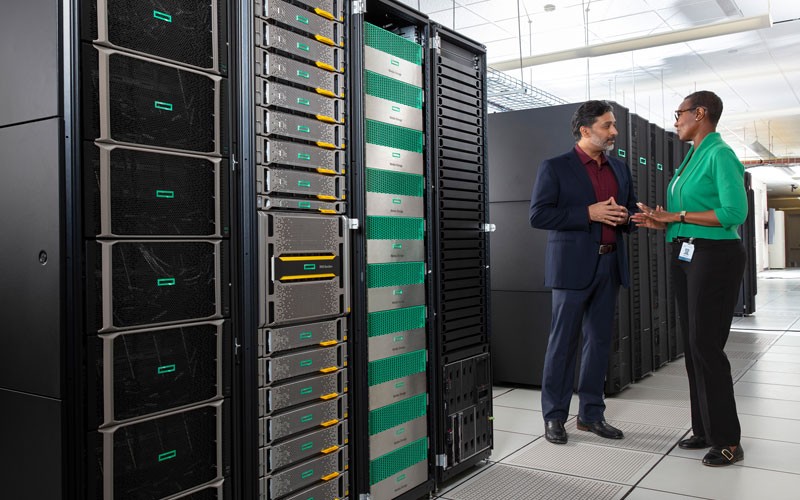HPE Servers’ Performance in Data Centers

HPE servers are widely regarded as high-performing, reliable, and well-suited for enterprise data center environments, consistently ranking among the top vendors globally. Here’s a breakdown of their performance across key dimensions:
1. Reliability & Stability (RAS Features)
Mission-Critical Uptime: HPE ProLiant (Gen10/Gen11), Synergy, and Integrity servers incorporate robust RAS (Reliability, Availability, Serviceability) features:
iLO (Integrated Lights-Out): Advanced remote management for monitoring, diagnostics, and repairs.
Smart Array Controllers: Hardware RAID with cache protection against power loss.
Silicon Root of Trust: Hardware-enforced security against firmware tampering.
Predictive analytics via HPE InfoSight for preemptive failure detection.
Result: High MTBF (Mean Time Between Failures) and minimal unplanned downtime.
2. Performance & Scalability
Latest Hardware: Support for newest Intel Xeon Scalable & AMD EPYC CPUs, DDR5 memory, PCIe 5.0, and high-speed NVMe storage.
Workload-Optimized:
ProLiant DL/ML: Versatile for virtualization, databases, and HCI.
Synergy: Composable infrastructure for dynamic resource pooling.
Apollo: High-density compute for HPC/AI.
Scalability: Modular designs (e.g., Synergy frames) allow scaling compute/storage independently.
3. Management & Automation
HPE OneView: Unified infrastructure management for servers, storage, and networking (automates provisioning, updates, and compliance).
Cloud Integration: Native tools for hybrid cloud (e.g., HPE GreenLake) and APIs for Terraform/Ansible.
HPE InfoSight: AI-driven analytics for optimizing performance and predicting issues.
4. Energy Efficiency & Cooling
Silent Smart Cooling: Dynamic fan control tuned for variable workloads.
Thermal Design: Optimized airflow (e.g., HPE Apollo 4000 supports direct liquid cooling).
Energy Star Certifications: ProLiant servers often exceed efficiency standards, reducing power/cooling costs.
5. Security
Firmware Integrity: Silicon Root of Trust ensures secure boot.
Cyber Resilience: Runtime intrusion detection, encrypted memory (AMD SEV-SNP, Intel SGX), and secure erase.
Zero Trust Architecture: Integrated with HPE Aruba networking for end-to-end security.
6. Hybrid Cloud & Edge Integration
HPE GreenLake: Consumption-based "as-a-service" model for on-premises data centers.
Edge Solutions: Compact servers (e.g., Edgeline EL8000) for rugged/remote deployments.
7. Support & Services
HPE Pointnext: Proactive 24/7 support, certified spare parts, and global service coverage.
Firmware/Driver Ecosystem: Regular updates with long-term lifecycle support.
Ideal Use Cases
Enterprise Virtualization: VMware/Hyper-V clusters on ProLiant.
Hybrid Cloud: GreenLake-managed private/hybrid environments.
AI/HPC: Apollo systems for GPU-heavy workloads.
SAP/Oracle: Mission-critical applications on Superdome Flex.
Considerations & Challenges
Cost: Premium pricing vs. white-box/OEM alternatives.
Complexity: Advanced features (e.g., Synergy/OneView) require training.
Ecosystem Lock-in: Best with HPE storage/networking for full integration.
Competitive Positioning
vs Dell PowerEdge: Comparable performance; HPE leads in composable infrastructure (Synergy) and AI-driven ops (InfoSight).
vs Cisco UCS: UCS excels in unified networking; HPE offers broader edge-to-cloud portfolio.
vs Lenovo ThinkSystem: Similar RAS; HPE has stronger hybrid cloud services (GreenLake).
Summary: HPE Server Strengths in Data Centers
Reliability: Industry-leading RAS + iLO management.
Automation: AI-driven ops (InfoSight) + composability (Synergy).
Efficiency: Energy-optimized designs + liquid cooling support.
Security: End-to-end Zero Trust + firmware hardening.
Hybrid Cloud: GreenLake consumption model + consistent API-driven management.
Bottom Line: HPE servers excel in demanding, large-scale data centers prioritizing stability, automation, and hybrid cloud flexibility. While priced at a premium, their RAS capabilities, management ecosystem, and global support justify the investment for enterprises with critical workloads. For SMBs or hyperscale web-tier deployments, cost may drive consideration of alternatives.



